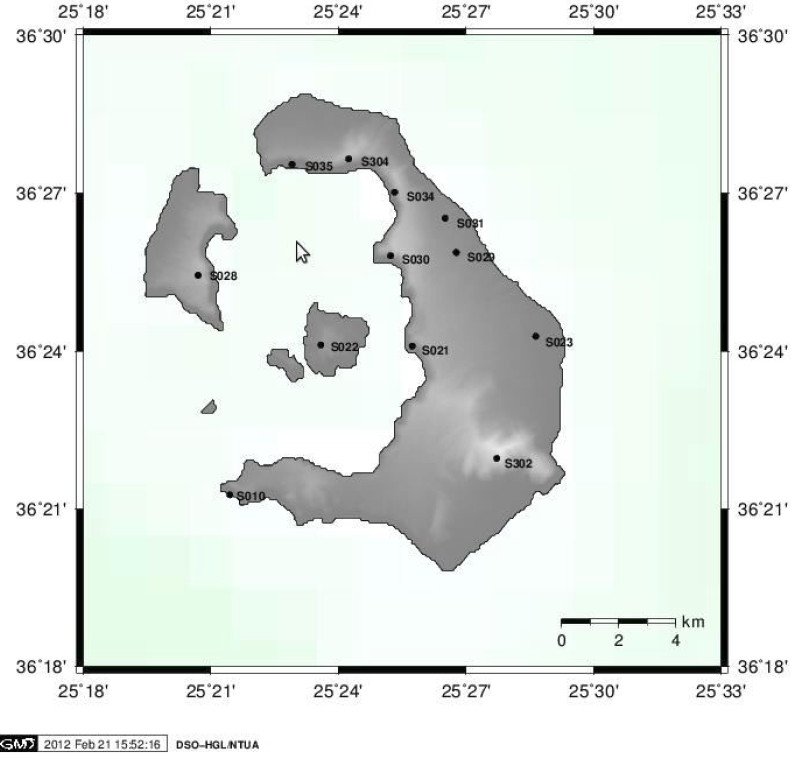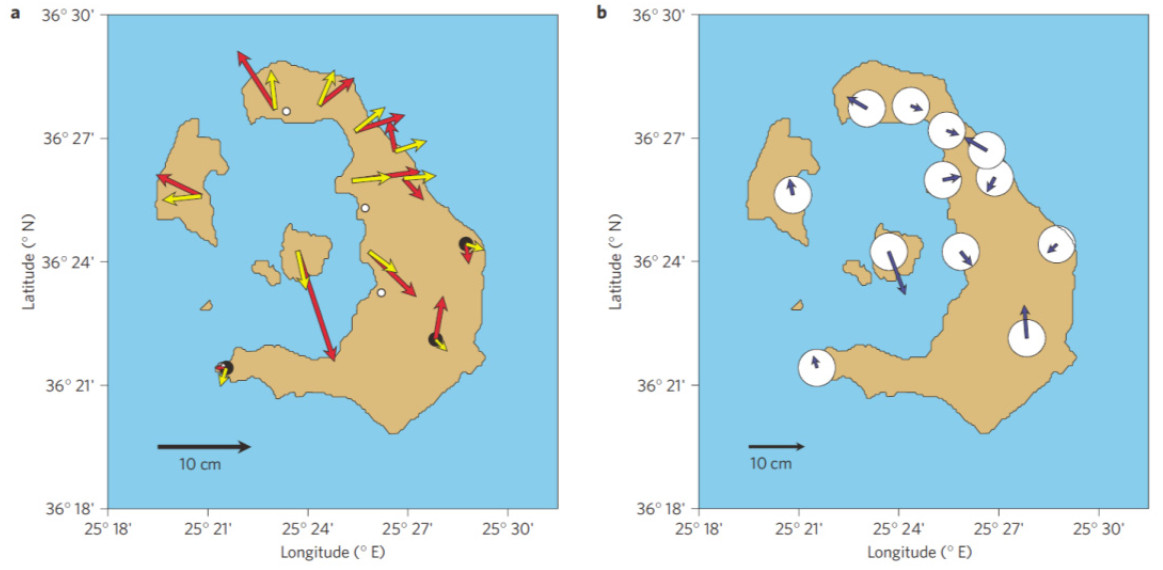Scientific Report 952
This report is also available as a PDF document .
Abstract
Loan 952 supported the deployment of three cGPS receivers to augment geodetic studies of the first episode of active deformation and seismicity of the modern era at Santorini volcano, Greece. The instruments were deployed from July to October 2011, and were used primarily to complete a dense reoccupation of the twelve Greek Military Triangulation Points on Santorini. Processing of these data, and comparison with the earlier occupations of the same network (in 1955 and in the 1980’s), provide the critical evidence that the episode of inflation at Santorini which took place from January 2011 July 2012 was indeed the first major episode of deformation a this volcano since 1955; and most probably since the last eruption, in 1950. A report of our analysis of the geodetic data, combined with an analysis of the InSAR data for the period 20102012 has recently been published in Nature Geoscience.
Background
In early 2011, during fieldwork by a PhD student, Michelle Parks, we became aware that an episode of unrest was beginning at the Greek island volcano of Santorini. Santorini is a classical caldera volcano, which experienced a major explosive eruption about 3600 years ago. Since that time, activity at the volcano has slowly built a steepsided edifice of dacite lava in the centre of the caldera. This edifice first broke the surface in an eruption about 2000 years ago, and over the past 500 years the volcanic island of Nea Kameni has enlarged significantly in the course of five major eruptions. Although the eruptions themselves have been well described (e.g. Fouque, 1879; Pyle and Elliott, 2006), very little has been recorded relating to the unrest of the volcano in between eruptions: in fact, most of the sparse information in the literature relates only to `precursor’ seismicity and rapid uplift that occurred within a few weeks to months of an eruption starting. Thus, from the outset it was apparent that the new phase of unrest was a great opportunity to understand what happens to large caldera volcanoes in between eruptions. Once we had been able to confirm that the seismicity within the caldera was also accompanied by significant ground deformation (as observed both by InSAR, and from the evidence of the small number of operating cGPS stations on Santorini in early 2011), we applied to NERC for Urgency Funding to support an intensive campaign of field measurements, and to the GEF for some cGPS receivers to augment our fieldwork.
The field-intensive phase of measurement ran from June to October 2011, and included both campaignstyle GPS measurements, as well the installation (with Greek colleagues from the National Technical University of Athens, NTUA) of several new permanent cGPS receivers, and field measurements of soilgas flux. The activity included both junior and senior researchers from Oxford; researchers from Greece, and, for a period in September 2011, an intensive phase of campaign measurements by our 4thyear undergraduate class, who were visiting Santorini as a part of their field training.
The primary objectives of the field campaign were to capture the early stages of a continuing phase of unrest on Santorini, Greece. NERC Urgency funding and the GEF loan enabled us to perform the following tasks:
- to reoccupy the Greek Military Triangulation Points on Santorini.
- to extend the network of continuous GPS receivers on Santorini and
- to complete field surveys of gas emission from New Kameni.
Figure 1 (below) shows the locations of the remaining Greek Military Triangulation Points on Santorini that we reoccupied during the field campaign.

Survey Procedure
For an initial survey in July 2011 we reoccupied campaign sites previously established by Dr Andy Newman (Georgia Tech) and his colleagues from the University of Patras. These sites are described and located in a recent paper in Geophysical Research Letters by Newman et al (2012). These campaign sites involved a mixture of pillar and tripod measurements. In September 2011, we reoccupied 12 Hellenic Military pillars (Fig. 1). We used a pool of equipment to do this, with instruments from both GEF and NTUA. During this campaign, several sites were occupied using the GEF receivers and choke ring antennae, but we used pillar plates from NTUA to mount the antennas on the pillars rather than using the tripods as these were too short. Sites were occupied for a minimum of 3 hrs during the September campaign and 24 hrs during the July campaign. We recognise that an ideal campaign survey may require longer occupation periods but in the case of the September campaign we were confident that 3 hours was sufficient because we used GPS observations from 3 closely located permanent stations on Santorini (SNTR, WNRY and DSLN) in the processing and we have short baselines from these cGPS sites to the pillars. SNTR was set up by University of Oxford/NTUA in 2005; WNRY and DSLN were set up in July 2011. The September survey campaign was carried out with the assistance of the 4th year undergraduate class from Oxford. This was an excellent educational experience for the students, who were enthused by the opportunity to participate in a field campaign.
The equipment provided by GEF was in very good condition and the setup proved to be very easy, once we had been trained. Probably the most difficult (and most important) task was programming the Leica receivers. Fortunately Colin Kay took us through the parameter file setup and the setup of equipment in the field which was extremely helpful. In the field, the most time consuming task when using a tripod setup was the levelling, but this became easier with experience. Overall, we were very pleased with the instruments.
Data quality, Processing, Modelling and Interpretation
Full details are presented in our recent paper (Parks et al., 2012), and we summarise the salient points below. We used chainstacked InSAR scenes from Envisat and TerraSARX to track the large scale deformation field of Santorini from January 2011 April 2012. We used a matlab script to invert the data for the bestfitting `Mogi’ source (spherical pressure source), and find that the best fit solution to both InSAR and cGPS data (from fixed stations) is for a Mogi source at about 4.5 km depth, located north of Nea Kameni, which is inflating at a rate of ~ 107 m3 yr-1 (Fig. 2, below). The location of this Mogi source has not changed significantly since May 2011. This is consistent with the unrest being due to the intrusion of a pulse of magma beneath the caldera.

We used the reoccupation of the triangulation points to investigate whether, or not, this current phase of deformation is the first such event since the last eruption in 1950. Triangulation observations were carried out on Santorini by the Hellenic Military Geographic Service in 1955. Each angle was the subject of 12 independent measurements, and processed in 1955 to yield a solution for coordinates (lat, long, orthometric height). For comparison with the GPS data, we subtracted the geoidal height from the orthometric height. We occupied the twelve surviving monuments from 23 26 September 2011, and the data from these sites and from four continuous GPS sites on Santorini were analysed using Bernese v5.0 GPS software. Coordinates were estimated in an ambiguityfixed solution, using absolute antenna calibration corrections and IGS final products. The datum was realised by means of minimum constraints imposed on IGS stations BORI, BUCU, GLSV, ISTA, MATE, NICO, NOT1, PENC, WTZR. The processing was compliant with current Center for Orbit Determination in Europe standards.
Due to the imprecision of distance measurements in 1955, the initial network contains an undetermined scale error. We account for this by taking the three points most distant from the centre of inflation, and subtracted from their 2011 coordinates the displacements calculated from our InSAR-constrained model for inflation. This is a small adjustment. We then found the best fit solution of the isotropic horizontal dilatation to the 1955 coordinates to the lengths of baselines in the adjusted 2011 coordinates. We adopt a conservative estimate of 20 mm for the uncertainty in positions of the original coordinates, based on past experience of comparison between triangulation surveys and GPS observations.
The results, which are shown in Fig. 3, below confirm that the amount of deformation measured across the triangulation network (from 19552011) is essentially completely accounted for by the deformation that has happened during the current episode of unrest. This is evidence for the pulsatory nature of magmatic intrusion events beneath longlived and dormant volcanoes.

Conclusions and recommendations
Use of GEF loan equipment was instrumental in our capturing of a short pulse of magma intrusion beneath Santorini volcano, and the confirmation that pulses of this scale happen only rarely in between eruptions. We are indebted to the staff of the facility for their expediting of our proposal, the rapid shipping of the equipment, and their dedication in being available at short notice to offer training in the field.
Publications
Peer‐reviewed papers:
Parks, MM, Biggs, J, England, P, Mather, TA, Nomikou, P, Palamartchouk, K, Papanikolaou, X, Paradissis, D, Parsons, B, Pyle, DM, Raptakis, C, Zacharis, V, (2012) ‘Evolution of Santorini Volcano dominated by episodic and rapid fluxes of melt from depth’, Nature Geoscience, 5, 749‐754, doi:10.1038/NGEO1562
DPhil Thesis:
Parks, M.M., 2013, Volcanic processes during eruption and unrest: combining satellite and groundbased monitoring at Galeras and Santorini volcanoes, Unpublished D.Phil. thesis, University of Oxford. Link to Oxford Research Archive: http://bit.ly/OeooNh
Press coverage (mentioning the GEF loan)
NERC Planet Earth Online (Feature article, Autumn 2012), http://planetearth.nerc.ac.uk/features/story.aspx?id=1273
Press Releases (from Oxford University, Bristol and ESA) were widely picked up by online media and news agencies, and coverage included print (Metro, UK, September 10th), television (Al Jazeera news, September 9th) and radio (BBC World Service, September 10th). Mainstream online coverage included National Geographic (http://news.nationalgeographic.com/news/2012/09/120912‐magmaballoon‐lava‐santorini‐volcano‐science)) and CBBC Newsround (http://www.bbc.co.uk/newsround/19549050).
Conference presentations on Santorini unrest (chronological)
Michelle Parks et al., Poster, Fall AGU, December 2011 Michelle Parks et al., Volcanic and Magmatic Studies Winter Meeting, January 2012 (Durham UK).
Michelle Parks et al., Invited talk, EPOS, University of Athens, Greece (January 2012).
David Pyle et al., Invited Talk, MeMoVolc meeting of the Special Scientific Committee, Santorini, Greece (March 2012).
Juliet Biggs et al., ESA meeting on Satellite Earth Observation for Geohazard Risk Management, Santorini, Greece (May 2012).
David Pyle et al., Science Highlights talk, NCEO Annual Conference, Nottingham (September 2012).
Michelle Parks et al., Talk, Wegener 2012 Conference, Strasbourg (September 2012).
Instrument deployment locations
In September 2011, we reoccupied 12 Hellenic Military pillars, using a pool of equipment from both GEF and NTUA. Sites were occupied for a minimum of 3 hrs, and we also used GPS observations from 3 permanent stations (SNTR, WNRY and DSLN) in processing and we have short baselines from these cGPS sites to the pillars.


